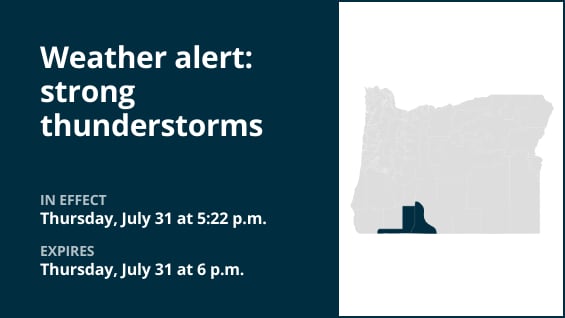At 5:22 p.m. on Thursday, the National Weather Service issued an updated weather notice for the Klamath Basin, Southern Oregon Cascades, and Siskiyou Mountains that warned of heavy thunderstorms through 6 p.m.
Be prepared for wind gusts of up to 50 mph and hail the size of a nickel (0.88 inches).
“At 5:21 p.m., Doppler radar tracked a strong thunderstorm near Rocky Point Upper Klamath Lake, or 26 miles northwest of Klamath Falls, moving east at 15 mph,” according to the weather service. Gusty winds have the potential to blow around unsecured objects and topple tree branches. It is possible for outdoor items to sustain minor harm.
Malone Springs, Rocky Point Upper Klamath Lake, and Fourmile Lake Campground are all under alert.
According to the weather service, “If outdoors, consider seeking shelter inside a building.”
Preparing for impending lightning strikes: Expert safety recommendations
Approximately 25 million lightning strikes occur in the United States annually, most of which take place in the summer. The weather service reports that lightning is the cause of death for about 20 persons each year. As thunderstorms get closer, the risk of lightning increases; it peaks when the storm is directly overhead and then progressively decreases as it passes.
Consider the following advice to keep yourself safe during a thunderstorm:
Plan for lightning safety:
-
When venturing outdoors, it’s vital to establish a clear plan for seeking shelter in case of lightning.
-
Stay vigilant by monitoring the sky for ominous signs and listening for the telltale sound of thunder. If thunder is audible, it’s a clear indication of nearby lightning.
-
Seek a safe place to shelter, preferably indoors.
Indoor safety precautions:
-
Once you’re indoors, avoid using corded phones, electrical devices, plumbing fixtures, and stay away from windows and doors.
-
Lightning can follow conductive pathways, and these precautions reduce the risk of electrical surges.
Hold off till the all-clear:
-
After the last lightning strike or thunderclap, wait at least 30 minutes before resuming outdoor activities.
-
It’s important to remember that lightning can strike even when a storm seems to have passed, so exercise caution.
When there is no indoor shelter:
Take these precautions to increase your safety if you are outside during a thunderstorm without access to inside shelter:
-
Avoid open fields, hilltops, or ridge crests, as they expose you to greater lightning risk.
-
Steer clear of tall, isolated trees and other prominent objects. In forested areas, stay close to lower stands of trees.
-
If you’re with a group, ensure individuals are spread out to prevent lightning current from transferring between people.
-
Camping in an open setting during a thunderstorm is strongly discouraged. If you have no alternative, set up camp in a valley, ravine, or other low-lying areas. It’s crucial to note that a tent provides no protection against lightning.
-
Do not approach water bodies, wet objects, or metal items. Although water and metal do not attract lightning, they conduct electricity effectively and can pose significant risks.
In conclusion, being alert and ready are your best defenses against lightning threats. You may put your safety first and drastically lower the likelihood of lightning-related mishaps by adhering to these rules.
Driving through downpours: Safety guidelines for wet roads
Roads can become dangerous when it rains. Keep yourself updated and heed these weather service recommendations to stay safe during periods of intense precipitation:
Watch out for swift water flow:
When it rains a lot, stay clear from parking or strolling near culverts or drainage ditches since the swift-moving water could carry you away.
Keep your distances from other vehicles safe:
In heavy rain, the two-second rule of following distance is your friend. To guarantee safe spacing under unfavorable circumstances, increase it to four seconds.
Reduce your speed and exercise caution:
Lowering your speed is essential on wet roads. To prevent skidding, gently release the gas pedal and refrain from applying sudden braking.
Pick your lane carefully:
On multilane highways, stay in the middle lanes to reduce the chance of hydroplaning because water tends to pool in the outer lanes.
Visibility is important.
Turn on your headlights to improve visibility in severe rain. Rain-stained windows can hide cars in blind situations, so be cautious.
Be cautious on slick roads:
Because of a combination of rain, oil, and grime, roadways are at their slickest during the first 30 minutes of precipitation. Be especially careful during this time.
Stay a safe distance away from big cars:
Tire spray from big vehicles and buses can make it harder to see. Pass them quickly and safely, and refrain from tailgating.
Be mindful of your wipers:
Visibility may be hampered by overloaded wiper blades. If the rain makes it very difficult to see, stop and wait for the weather to clear up. Look for cover in covered areas or rest areas.
Position your car as far off the road as you can, preferably beyond guardrails, if stopping by the side of the road is your only choice. To let other cars know where you are, turn on your emergency flashers and keep your headlights on.
Taking these safety measures will significantly improve your road safety while it’s raining a lot. For a safe trip, keep yourself updated on weather conditions and follow local authorities’ instructions.
United Robots offers a service called Advance Local Weather Alerts that gathers the most recent information from the National Weather Service using machine learning.





More Stories
Update: Nickel-sized hail predicted with thunderstorms Thursday
Update: Nickel-sized hail predicted with thunderstorms Thursday
Update: Nickel-sized hail predicted with thunderstorms Thursday